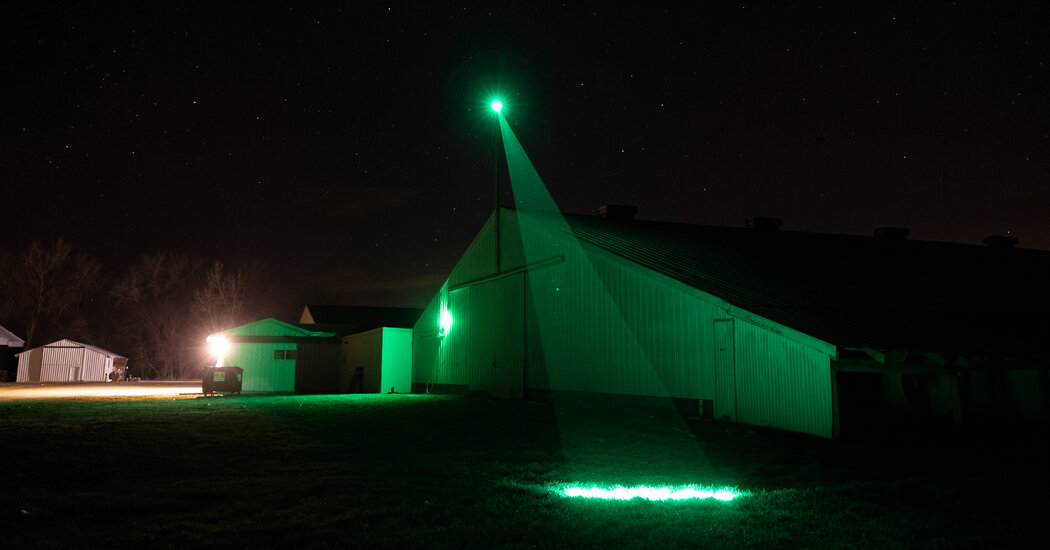Loren Brey, a poultry grower in Minnesota, walked onto the farm where his egg-laying turkeys nest in November to discover a handful of hens, dead from the highly pathogenic avian flu.
Within a week, he lost nearly half of his entire flock.
So when Mr. Brey’s turkeys began producing eggs again in the spring, he gave a seemingly unconventional prevention method a go: lasers installed atop his barns, firing beams of green light to fend off wild ducks, owls and other possible carriers of the deadly virus.
As migratory birds fly north for the spring, poultry farmers and backyard keepers across the country are bracing for yet another outbreak of avian flu. Although the most recent strain has felled only a small portion of the nearly 10 billion chickens, turkeys, ducks and other birds sold across the country each year, some poultry growers like Mr. Brey are turning to innovative tactics to protect their flocks, deploying deterrents like drones, air horns, balloons and decoy predators.
The practices underline the scramble by smaller farms and even some larger-scale operations to ward off the virus, as well as the fatigue, and begrudging acceptance, of the illness after years of sanitation protocols, lockdowns and debates over vaccination.
The most affected appear to be large-scale industrial farms and those raising egg-producing chickens: two-thirds of the depopulated birds belong to just 30 farms with one million or more egg-laying hens. Turkey operations, like Mr. Brey’s, have also been hit hard, representing 350 of the 481 commercial farms with detected cases. The birds are particularly susceptible to infection, and are more exposed to the virus because many turkey farms sit within the migratory path for many wild waterfowl, said Dr. Carol Cardona, an expert in avian health at the University of Minnesota.
An infection carries vast consequences.
Under federal policy, one infected bird can necessitate the culling or elimination of an entire flock, and then disposing of the carcasses through composting, burial, incineration or rendering. The regulation has resulted in 90 million dead birds and more than 1,100 affected flocks across the country since February 2022, when the strain, the most lethal yet in the United States, was first detected.
Because areas where infected birds once lived must be disinfected and quarantined, and repopulating a flock takes time, production can be halted for months. As a result, the total number of egg-laying hens has declined by about seven million from 2021 to 2023, producing a billion fewer eggs a year — and contributing to spikes in cost.
Christian Alexandre, 32, who raises egg-laying chickens on 300 acres of grassland nestled between coastal redwoods and the Pacific Ocean near Crescent City, Calif., said it took half a year before production capacity was fully restored after bird flu was detected in late 2022.
“The toughest part for farmers is losing the birds, for sure. And then losing the work for your employees and not being able to supply your customers,” he said, adding that depopulating and composting the bodies afterward was traumatic.
Mr. Alexandre collects eggs by hand from mobile coops with no doors and no floors to ensure the birds full access to the outdoors. Rather than restocking with newly hatched chicks and waiting months for them to grow, he instead bought “spent” brown, organic hens, or layers that have reached the peak of their egg-producing days. Nearly 3 years old, the birds lay fewer eggs per day than younger hens, but Mr. Alexandre’s farm is back to full capacity, producing 10,000 to 12,000 eggs a day.
To prevent another outbreak, Mr. Alexandre now limits farm tours and sanitizes thoroughly, but he vowed to stick to his convictions. As president of the American Pastured Poultry Association, he said he was aware of only a handful of cases among his membership of 1,100 farmers. “Am I afraid of getting it again? Not enough to lock my birds inside,” he said.
Mr. Alexandre also tried installing lasers on his farm. But after a while, starlings began learning the lasers’ patterns and no longer feared the lightsaber-like beams.
Acknowledging that the deterrents were not foolproof, Craig Duhr, a sales manager for the Bird Control Group, which makes the lasers, said demand ticked up every time there was an outbreak. Dairy farmers, he said, were now seeking to install the system, which start at $12,500 per unit, since the disease was detected in cows last month.
Other safeguards that farmers have turned to in a bid to ward off potentially deadly carriers, according to Dr. Cardona: netting, noise machines and inflatable dancers. “Scary man, you know, the dudes that blow up,” she said. But she emphasized that the seasonality and evolving nature of the virus meant that farmers should regularly enhance safety measures.
“It’s like sprints, like reps. You do a sprint. And then you rest. Then you sprint again,” Dr. Cardona said. “You use that rest time to build your resiliency and make sure you’re ready for the next season. And then you hope and pray.”
To build that resiliency, experts and officials recommend following certain protocols: minimizing visitors, cleaning and disinfecting vigorously, keeping water and feed away from wild birds and mammals, and isolating newly purchased birds or those returning from crowds, among others.
Still, the avian flu can sneak into the most stringently locked-down coops. Mr. Brey, for one, has a designated parking spot for anyone coming in contact with his turkeys, Danish entry systems where people can clean and disinfect themselves and filtered air inlets.
“You can tighten and tighten up your biosecurity until you’re blue in the face. Like, what time is it now? Three o’clock? I’m on my eighth shower today already,” said Mr. Brey, who has been raising birds for three decades.
That constant vigilance has strained the patience of some poultry farmers.
Samantha Gasson, who raises 2,000 broiler chickens — those grown for meat — and 400 turkeys on pasture in North Carolina, has followed standard protocols and flies drones to stave off senate vultures, which can carry the virus and circle her lambs and cows.
But after years of worrying about the virus, she has now learned to cope with it, comparing her response to burnout from the pandemic.
“With Covid, in the beginning, I was definitely one of those people who masked up and gave everybody 20 feet,” said Ms. Gasson, who works for an animal welfare and food safety nonprofit. “And with the flu, it was the same thing. In that first year, I definitely lost sleep over it. Since then, it’s just like OK, it’s a part of life.”
Rachael Arestad used to scan the federal case tracker that monitors the spread of avian flu almost daily when the current strain confined her 18 chickens inside their pink, home-built coop in her backyard in rural Connecticut.
Two years in, her watchfulness has waned. Ms. Arestad will still periodically check to see if the virus has been detected close by, avoid dog parks covered in geese droppings and tie balloons in her yard to scare off foxes, which may bring the virus or attack her birds. But the thought of keeping her chickens, whom she considers pets, in perpetual lockdown is unappealing.
“I just hope at some point in the future, they’ll offer a vaccine for backyard chicken people,” she said. “We’re not selling our chickens overseas, right? We just want to see happy, healthy flocks.”
Mr. Brey, who also serves as the president of the Minnesota Turkey Research and Promotion Council, sounded a note of resignation when it came to properly warding off the bird flu.
“You lay awake in bed for days and days, like, how in the world?” he added. “How, how, what should I do different? I don’t know that answer.”




Your point of view caught my eye and was very interesting. Thanks. I have a question for you.